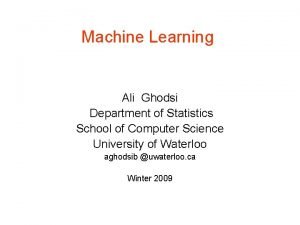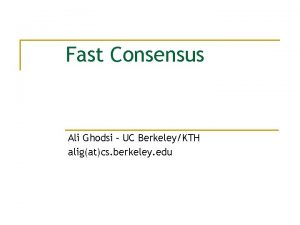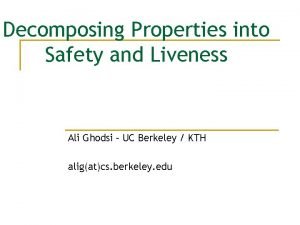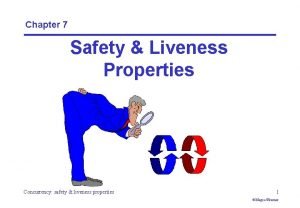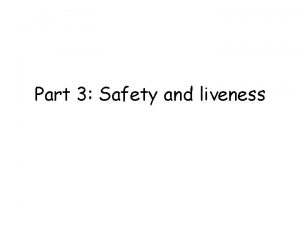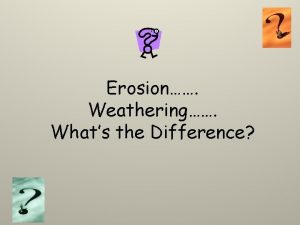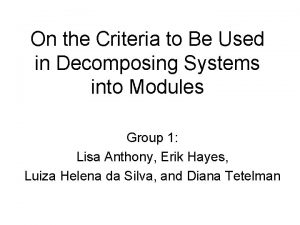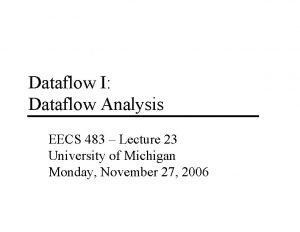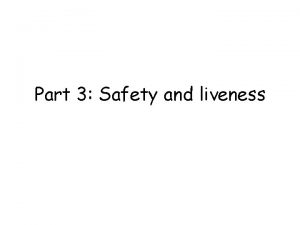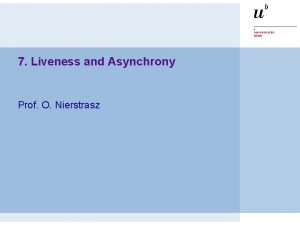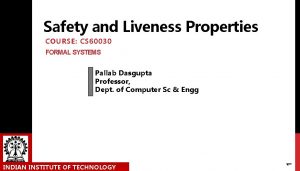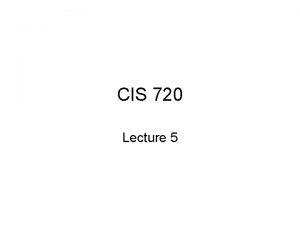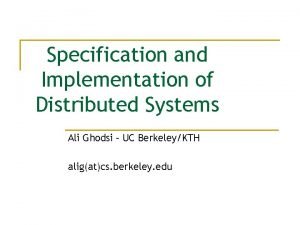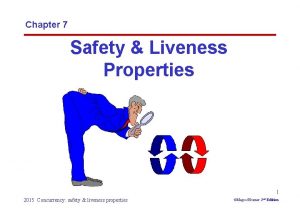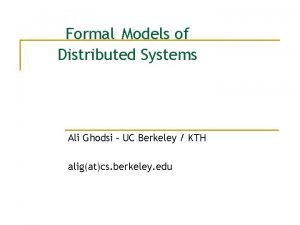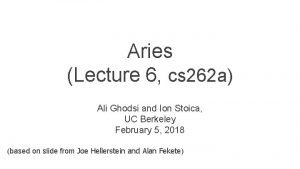Decomposing Properties into Safety and Liveness Ali Ghodsi















- Slides: 15

Decomposing Properties into Safety and Liveness Ali Ghodsi – UC Berkeley / KTH alig(at)cs. berkeley. edu

Safety & Liveness All That Matters n This lecture: q “Any specification can be expressed as the conjunction of a safety property and a liveness property” - Alpern & Schneider, Inf. Proc. Letters 1985 n Example q P is that every message sent is delivered exactly once q Q is that every message sent it delivered at most once q R is that every message sent is delivered at least once n P is neither safety nor liveness q Q is safety, R is liveness, and P ↔ Q R n Rest of lecture: show that this can be done for any property P 2/23/2021 Ali Ghodsi, alig(at)cs. berkeley. edu 2

Definitions n n S set of states of the distributed system An execution is an infinite sequence of states q Assume E is an execution n q q E[. . i] is the finite prefix of size i of E E[i. . ] is the infinite suffix of E starting at the i: th state Concatenation is done with ◦, e. g. E[. . i]◦F S set of all possible executions S set of all prefixes of executions (finite strings) 2/23/2021 Ali Ghodsi, alig(at)cs. berkeley. edu 3

Definitions (2) n n A property P is a predicate over executions, i. e. a function retuning true/false (1/0) for every execution q Equivalently, P is the set of executions for which the property holds q We use former definition when using functional notation, e. g. P(E) = true Recall De Morgan’s Law for quantifiers q q X : P(X) ↔ X : P(X) 2/23/2021 Ali Ghodsi, alig(at)cs. berkeley. edu 4

Definition of Safety n A property P is a safety property iff E S : P(E) i ℕ : F S : P(E[. . i]◦F) n Equivalently, any execution not satisfying the property has some prefix, for which any infinite extension will not satisfy the property q If an execution E violates P, then some bad event happened so that every execution with the prefix of E containing the bad event must also violate P 2/23/2021 Ali Ghodsi, alig(at)cs. berkeley. edu 5

Definition of Liveness n A property P is a liveness property iff E S : F S : P(E◦F) n Every finite prefix must have an infinite extension in P q q For every prefix of an execution, there must exist some continuation where something good happens, making that execution satisfy P “As long as there is life, there is hope” - Cicero 2/23/2021 Ali Ghodsi, alig(at)cs. berkeley. edu 6

Main Theorem n Every property P is equivalent to the conjunction ( ) of two properties Q and R q q n n where Q is a safety property, and Where R is a liveness property Let safe. P denote Q Let live. P denote R 2/23/2021 Ali Ghodsi, alig(at)cs. berkeley. edu 7

Baby steps… n First step… q P is always equivalent to the conjunction of two properties safe. P and live. P n n n Let q q q n n NB: We haven’t claimed that safe. P is a safety property NB: We haven’t claimed that live. P is a liveness property safe. P(E) = P(E) MP(E) live. P(E) = P(E) MP(E) For some predicate MP which we define later Hence, safe. P is P with some additional executions Similarly, live. P is P with some additional executions 2/23/2021 Ali Ghodsi, alig(at)cs. berkeley. edu 8

Baby steps… (2) n Let q q n safe. P(E) = P(E) MP(E) live. P(E) = P(E) MP(E) Then P(E) ↔ safe. P(E) live. P(E) q q q i. e. P(E) ↔ [ P(E) MP(E) ] If P(E)=true, then both clauses become true [ ] If both clauses are true, then P(E) must be true since MP(E) and MP(E) cannot both be true [ ] 2/23/2021 Ali Ghodsi, alig(at)cs. berkeley. edu 9

Remaining steps… n Need to prove q q n safe. P is a safety property live. P is a liveness property Define q MP(E) = i ℕ : F S : P(E[. . i]◦F) n q q i. e. MP(E) is true if every prefix of E has some extension making it true under P Note that De Morgan’s gives MP(E) = i ℕ : F S : P(E[. . i]◦F) 2/23/2021 Ali Ghodsi, alig(at)cs. berkeley. edu 10

Intuition of safe. P(E) n safe. P adds to P all executions true under MP q MP(E) = i ℕ : F S : P(E[. . i]◦F) n n i. e. MP(E) is true if every prefix of E has some extension making it true under P Is it possible that P(E)=false but MP(E)=true? q Yes, let set of state S={0, 1}, n n n P={ E | E is execution with 0 everywhere but one position } The execution of all zeroes Z=000… isn’t in P MP(Z)=true since every prefix of Z has many extensions in P q 2/23/2021 Just add a 1 after the prefix, and then add infinite 0’s… Ali Ghodsi, alig(at)cs. berkeley. edu 11

Intuition of live. P(E) n live. P adds to P all executions true under MP q MP(E)= i ℕ : F S : P(E[. . i]◦F) n n i. e. MP(E) is true if there is a prefix of E, whose every extension is false under P Is it possible that P(E)=false but MP(E)=true? q Yes, let set of state S={0, 1}, n n n 2/23/2021 P={ E | E is execution with 0 everywhere but one position } The execution of all zeroes Z=1100000… isn’t in P MP(Z)=true since every extension of “ 11” is false under P Ali Ghodsi, alig(at)cs. berkeley. edu 12

Remaining steps… n Recall q MP(E)= i ℕ : F S : P(E[. . i]◦F) n n q i. e. MP(E) is true if every prefix of E has some extension making it true under P i. e. there is always “hope” for every prefix of E MP(E)= i ℕ : F S : P(E[. . i]◦F) n n 2/23/2021 i. e. MP(E) is true if there exists a prefix of E for which every extension is false under P i. e. some “bad” event happens in E after which we cannot recover Ali Ghodsi, alig(at)cs. berkeley. edu 13

We are safe! n Claim q q n safe. P(E)=P(E) MP(E) is a safety property where MP(E)= i ℕ : F S : E[. . i]◦F P Must prove that if E violates safep, any extension of some prefix of E will always violate safep q q q Assume safe. P(E)=false for some execution E Then P(E) and MP(E) false, and hence MP(E)=true Recall MP(E) = i ℕ : F S : E[. . i]◦F P Hence, there is some finite prefix G of E, for which any extension violates P But i ℕ : F S : E[. . i]◦F MP since MP(G◦F)=false Thus safe. P(E) is a safety property! 2/23/2021 Ali Ghodsi, alig(at)cs. berkeley. edu 14

We are alive! n Claim q q n live. P(E)=P(E) MP(E) is a liveness property where MP(E) = i ℕ : F S : E[. . i]◦F P Must prove that any prefix G has extension in live. P q q q For any extension E of G, either live. P(E) is true or false If live. P(E)=true then we are done If live. P(E)=false, then P(E)=false= MP(E), and MP(E)=true n Recall MP(E)= i ℕ : F S : E[. . i]◦F P n Hence, every prefix of E has some extension in P q q I. e. every prefix of E (in particular G) has some extension in livep Thus, every prefix G can be extended to true under live. P, making it liveness property 2/23/2021 Ali Ghodsi, alig(at)cs. berkeley. edu 15
 Ali ghodsi waterloo
Ali ghodsi waterloo Ali ghodsi berkeley
Ali ghodsi berkeley Safety liveness
Safety liveness Safety and liveness in concurrency
Safety and liveness in concurrency Safety liveness
Safety liveness Decomposing vectors
Decomposing vectors Decomposing breaking up or changing the color of rocks
Decomposing breaking up or changing the color of rocks On the criteria to be used in decomposing systems
On the criteria to be used in decomposing systems Liveness analysis calculator
Liveness analysis calculator Liveness
Liveness Extensive vs intensive properties
Extensive vs intensive properties Chemical and physical properties
Chemical and physical properties What is catzoc
What is catzoc Safety care behavioral safety training
Safety care behavioral safety training Process safety vs personal safety
Process safety vs personal safety Ind safety report
Ind safety report
